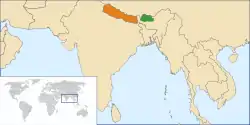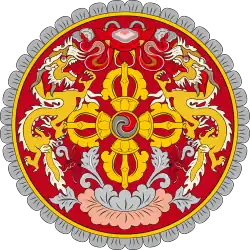 | |
Bhutan |
Nepal |
|---|---|
Bhutan–Nepal relations refer to the bilateral relations between the Bhutan and Nepal. Relations were formally established in 1983.[1] The two Himalayan countries are both landlocked, separated only by the Indian State of Sikkim. Both countries are bordered by India and the People's Republic of China. However, the current state of relations remains strained owing to the Bhutanese refugee crisis.[2]
Status
Bhutan and Nepal are both Himalayan countries and until 2008, Nepal was also a monarchy. Both nations were founding members of the South Asian Association for Regional Cooperation (SAARC). The Nepal-Bhutan Friendship and Cultural Society was established in Kathmandu to facilitate good relations in 1969.[3] The two nations had formally established diplomatic relations in 1983.[3] Bhutanese King Jigme Singye Wangchuck visited Nepal to attend the 3rd SAARC summit in 1987. Nepal's late King Birendra visited Bhutan to attend a SAARC meeting in 1988. More recently, the Prime Minister of Bhutan visited Nepal in 2002. PM Tshering Tobgay of Bhutan visited Nepal on 2015 to attend a SAARC summit.
Refugee crisis
A major issue confronting both nations is the presence of Bhutanese refugees, residing in seven UNHCR camps in eastern Nepal. Estimates of their numbers vary from 85,000 to 107,000. While most refugees claim Bhutanese nationality, Bhutan claims that they are "voluntary emigrants" who forfeited their citizenship rights, denying their refugee status. Most of the refugees are Lhotshampa - Nepali-speaking Hindus of Nepalese descent who had settled in Bhutan.[4][5][6] Several insurgent groups, including those with Maoist affiliations, have arisen from the refugee camps, whom Bhutanese security forces blamed for a series of bombings in Bhutan before the 2008 parliamentary elections.[5][6] After years of talks and efforts produced no results, several other nations, most notably the United States agreed to absorb 60,000 refugees.[6]
Trade
The growth of trade between the two nations has been affected by the refugee crisis. In 2008–09, Bhutan's exports to Nepal stood at Rs. 300 million, while Nepal's exports to Bhutan amounted to Rs. 200 million. In 2004, Nepal and Bhutan signed an agreement to increase the number of flights between Paro and Kathmandu from twice a week to seven flights a week. Delegations of chambers of business of both nations have exchanged visits, and in 2010 both nations held joint secretary-level talks to work towards a trade agreement.[7]
See also
References
- ↑ "Nepal - Bhutan Relations - Ministry of Foreign Affairs Nepal MOFA". mofa.gov.np. Retrieved 2021-01-11.
- ↑ Dhakal, Suman (March 2003). "Nepal - Bhutan Relations (A Study of Its Past)" (PDF). Digital Himalaya. Archived (PDF) from the original on 8 Jun 2012. Retrieved 8 October 2021.
- 1 2 Savada, Andrea Matles, ed. (1993). Nepal and Bhutan: Country Studies (3rd ed.). Washington, D.C.: Federal Research Division, Library of Congress. p. 333. ISBN 0-8444-0777-1. OCLC 27429416.
 This article incorporates text from this source, which is in the public domain.
This article incorporates text from this source, which is in the public domain.{{cite book}}: CS1 maint: postscript (link) - ↑ Stuart Notholt (2008). Fields of Fire: An Atlas of Ethnic Conflict. Troubador Publishing Ltd. p. 5.19. ISBN 978-1-906510-47-3.
- 1 2 "Background Note: Bhutan - Bureau of South and Central Asian Affairs". U.S. Department of State. Retrieved 2010-09-18.
- 1 2 3 "First of 60,000 refugees from Bhutan arrive in the U.S." CNN. 2008-03-25. Retrieved 2010-09-18.
- ↑ "Bhutan-Nepal trade talks". Bhutan News Service. 2010-03-18. Archived from the original on 2011-07-07. Retrieved 2010-09-18.
